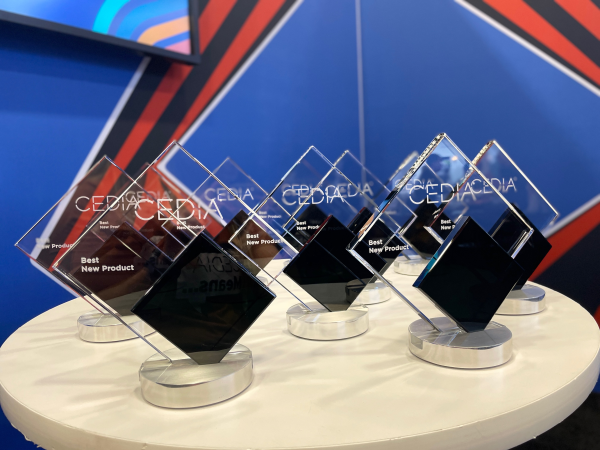The CEDIA Awards program and its judges have celebrated some of the most impressive residential technology design and installations in the world. As a past judge for 10 years, I can attest to the quality of the judges, the process, and the time commitment made by all involved. The process, criteria, and requirements have matured over the years and have adopted standards and recommended practices set by the industry.

Judge Selection
Selecting judges for the judging panel is not something CEDIA staff take lightly. Recommendations come in from staff members and industry volunteers. An ideal candidate “has a strong knowledge and understanding of industry standards and is an expert in one of the main three categories (integration, audio, and video) so that the scoring balances out well and the discussions are lively,” says member program manager Jessica Thornburg.
When meeting with the other judges and discussing the finalists, each judge digs deeper into an entry in the areas of their specific focus. As they go, judges inform the others of what they noticed, discovered, and what excited them about the submission. These expert volunteers take their roles seriously, which you can see in their notes and comments when they discuss the project winners.
Judging Process
The judging process starts before the judges even get involved. CEDIA staff initially work through the submissions to confirm they’ve met the base requirements for technical documentation, images, videos, and other required items for entry. Additionally, the initial review ensures there are no company logos, names, or customer information on any of the documents or images, so submissions are as anonymous as possible.
To add more anonymity and fairness to the judging process, the European (EMEA) judges score the U.S. and Asia Pacific (APAC) submissions, and the U.S. judges score the EMEA submissions. This also allows a judge’s company to submit for an award without a conflict of interest. When all submissions have been checked by the CEDIA awards team, the judges have a kickoff call to go over the criteria, timelines, and the software used to manage the process.
The judges gain access to the entries on the same date and generally have four-to-six weeks to score anywhere from 50 to 120 entries depending on the year. Each judge has their own technique and process of working through the entries. Regardless of their process, it generally takes each person the entire allotted time because it’s very time intensive. Some entries can have 30 to 100-plus pages of documentation that the judges review thoroughly.
Once scores have been submitted by all judges, CEDIA staff process the numbers and arrive at a list of finalists for each category. At the final judging meeting, the judges decide who will place as a winner and runner up for each category based on scores and group discussion. These meetings are where every little aspect of the projects will be reviewed — some of the most exciting conversations in the awards process.
Once the final decisions are made, the chairs and co-chairs of the regional panels meet and decide on the global winners. It’s a fulfilling process to see how much excellent work members of our industry can accomplish.
Judging Criteria and Scoring
Each awards category has minimum submission requirements including completing essay questions and uploading documentation, images, and videos. The essay questions provide a backstory for the project and give the judges an idea of the customer’s request, need, and the technical challenges the integrator encountered, as well as key project highlights. The required documents allow the judges to dig into the bones of a system, which is where their personal expertise and industry experience comes into play.
The judges look through the bill of materials (BOM) and engineering schematics to make sure the products are adequate and that the drawings provide all necessary information for a quality installation. The documentation should be thorough and accurate enough that someone could review them and take over the project without having to investigate anything further.
The images and videos wrap up the process for the judges. It allows them to confirm the equipment listed in the BOM is being used and that the craftsmanship is at the highest level, making it deserving of a CEDIA Award. The glamour shots are nice, but what really gets the judges excited is a well-dressed rack, groomed wire runs, easy-to-read labels, and properly placed Velcro.
The subcategory winners for rack-building, documentation, innovation, lighting, and user interface are chosen by the judges from the pool of submitted projects. The judges will generally make a note on a project while reviewing if they feel it’s good enough to win one of these. At the end of the final judging meeting, the group debates what projects they feel did the best in each category.
Dedicated volunteers and staff are always striving to give their best effort to help the judging for the CEDIA Awards. This tedious process requires industry professionals with years of knowledge and experience to take time out of their schedules to review many submissions in a short period of time.
Because of their own experiences, the judges understand that integrators have a challenging job to create and deliver these systems to their customers, often exceeding ever-changing expectations. They do their best to provide positive and constructive feedback on every project to help the integrators be better at their craft.
In this group of CEDIA volunteers, there’s a lot of respect for the industry and for those submitting their projects to this level of scrutiny. The awards program is about celebrating the excellence, dedication, and quality of technology integrators who hold standards and customer satisfaction at the top of their list.
Visit CEDIA.net to see this year’s CEDIA Awards finalists in the Americas, EMEA, and Asia Pacific (APAC) regions.






